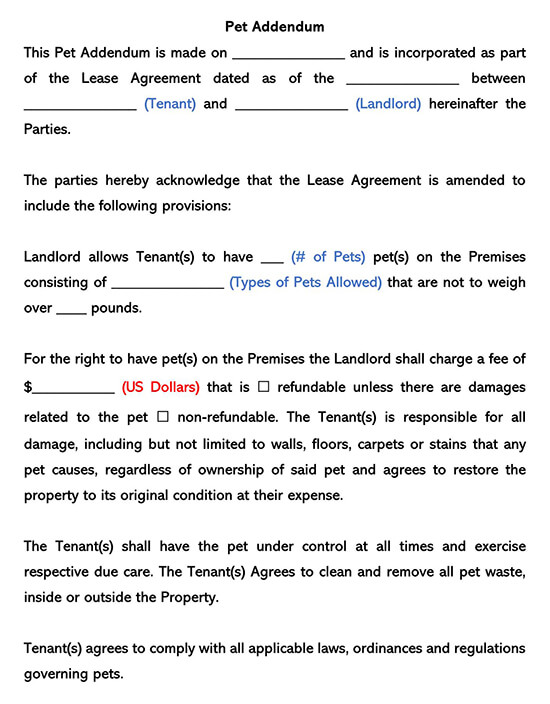There are some situations that arise when renting out a property, where an addition needs to be added to an original lease agreement. One such situation is when allowing pets to live in the rental.
EXAMPLE
If the original lease agreement states no pets allowed but you make exceptions based on pet type, breed, and size, you would use a Pet Addendum to Lease document to the original lease.
Free Template
You can download our template or sample to get a better understanding of what a pet addendum to a lease document should look like. Download our free templates, edit them as needed, and effortlessly create reliable and standardized pet addendum to a lease agreement.
What is a Pet Addendum?
A Pet Addendum is a document, separate from the original lease agreement, that details the exceptions and rules around allowing pets on or in the rental property. The agreement is only binding and legal when both the landlord and tenant agree to and sign the addendum.
This type of addendum can be used if your original lease agreement is a bit vague regarding pets or says no pets are allowed. There are some situations where a landlord will allow pets on a tenant-by-tenant basis
EXAMPLE
A tenant who has a service dog and needs the pet to get around. You can also use the addendum to iron out the details of what types of pets are allowed and any fees or deposits required, along with who is responsible for any damages by the pet.
What a Pet Addendum Should Include
While every addendum will be different based on the situation, there are some basic elements that you should have in your Addendum.
- Dates – you should make reference to the date of the original lease agreement and the date the addendum is being added.
- Location – list the location of the rental property that the pet will be staying in.
- Name of the landlord
- Name of the tenant/owner of the pet
- Pet details – this should include the name, breed, age, weight, gender, and color of the pet.
- Fees – detail any fees or charges for allowing the pet
- Damage and deposits – detail what amount will be returned if there is no damage once the tenant vacates the property, as well as what fees will be charged for any damage to the property.
- Additional rent – some landlords will charge an additional amount of rent to cover the wear and tear of having a pet in the property.For the addendum to be binding, both the tenant and landlord must sign and date the document.
Other details that you can include
There are other details that you may wish to include in your pet addendum, such as what you expect from the tenant:
- That they are responsible for their pet at all times
- That they are mindful and considerate to neighbors regarding pet noise
- That their pet is kept in a specific area when you are not home with them, and that they aren’t left unattended for long periods of time
- That they are kept on a leash or fenced-in area
- That they always clean up after their pets
- That their pets are fully vaccinated and spayed/neutered
- That they are responsible for the cost of anything that needs replacing or repairing due to damage by their pets
- That they have insurance and name the landlord as an additional insured person should your pet scratch or bite anyone
Why a Pet Agreement is Needed
It is not just an agreement between the tenant and the landlord to allow pets. Many pet adoption agencies will require you to present the pet agreement as proof of consent from the landlord that a pet is allowed.
As a landlord, it’s important to have a pet addendum to an existing lease to protect them from liability and damages caused by the pet, for example, destroying property or attacking another tenant.
Not having one in place, or keeping a pet without consent, can lead to a number of consequences for both the landlord and the tenant:
For landlords
- Having to look for a new tenant
- Unexpected damages
- Can end up paying an HOA fee
- Having to replace items like carpeting, skirting, etc
- Neighbor complaints
- Injuries to others by pet
- Lost time and money evicting a tenant
For tenants
- Having to look for somewhere else to live
- Having to rehome your pet
- Having to pay for damages
- Having to pay penalties or fines
TIP
Make sure you check local and state laws regarding legislation that is specific to certain breeds. Many dog breeds, for example, are classed as dangerous, and you may be fined for owning one of these breeds.
Benefits of Allowing Pets
There are some benefits to allowing tenants to have pets. For a start, your tenants will more than likely stay for longer, especially if rentals that allow pets are hard to come by. For a landlord, this means less turnover of tenants and less time having to find new ones. Most pet owners who look after their pets well tend to be more responsible, which means they will look after the property well too. There is also the benefit of being able to charge above the rental market rates when allowing pets. Having tenants with pets also creates a community of support.
Exceptions to No Pet Rules
There are some exceptions to “no pet” policies set out by the Fair Housing Act. Tenants who have emotional or physical disabilities and need to have a service animal, such as a guide dog. As a result, landlords may not be able to withhold deposits for pet damage for tenants who need a guide or service dog. It’s important the check your local and state laws.
As a landlord, a pet addendum means:
- You are not held liable or sued if the tenant’s pet harms someone else or another pet when on the property
- You have the right to decide if a pet is no longer allowed due to violation of the pet addendum agreement
- It gives you the right to enforce the original lease agreement.
Frequently Asked Questions
If a lease agreement has already been signed and the term started, the landlord can’t make pet policy changes until the term of the lease has ended. At that point, a new tenancy term can be offered with the new pet addendum.
This can depend on the laws in your state, but generally, a one-time fee between $200 to $500 is normal.
If you are paying an additional pet rent each month, it’s generally for the added wear and tear of the property when having a pet live there. It’s separate from the pet deposit fee. By law, landlords are not required to allow tenants to have pets unless it is a service pet.













